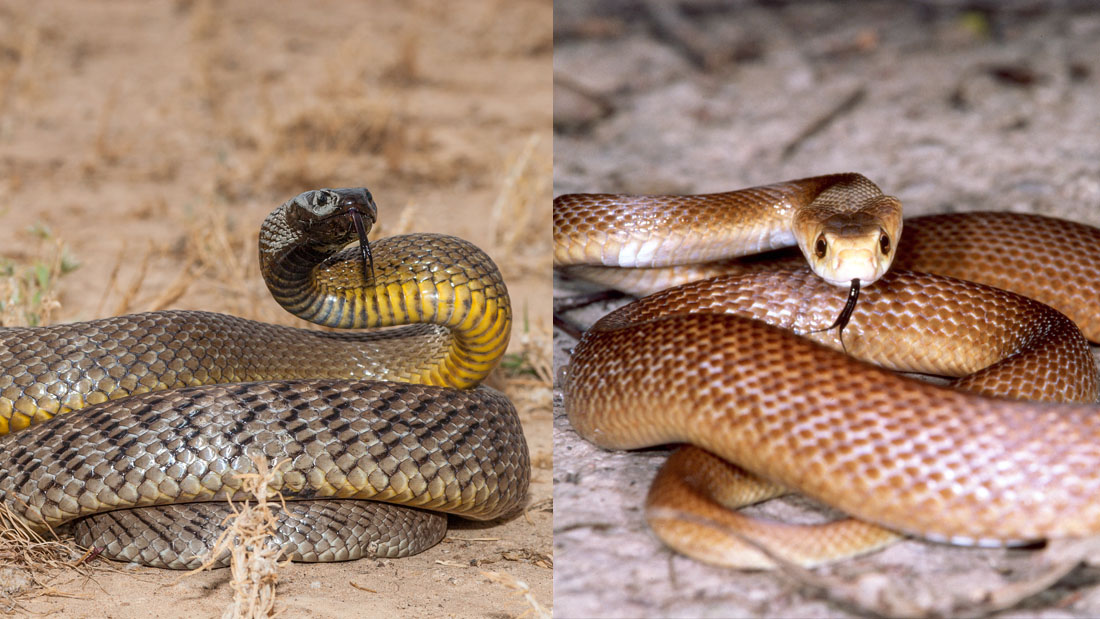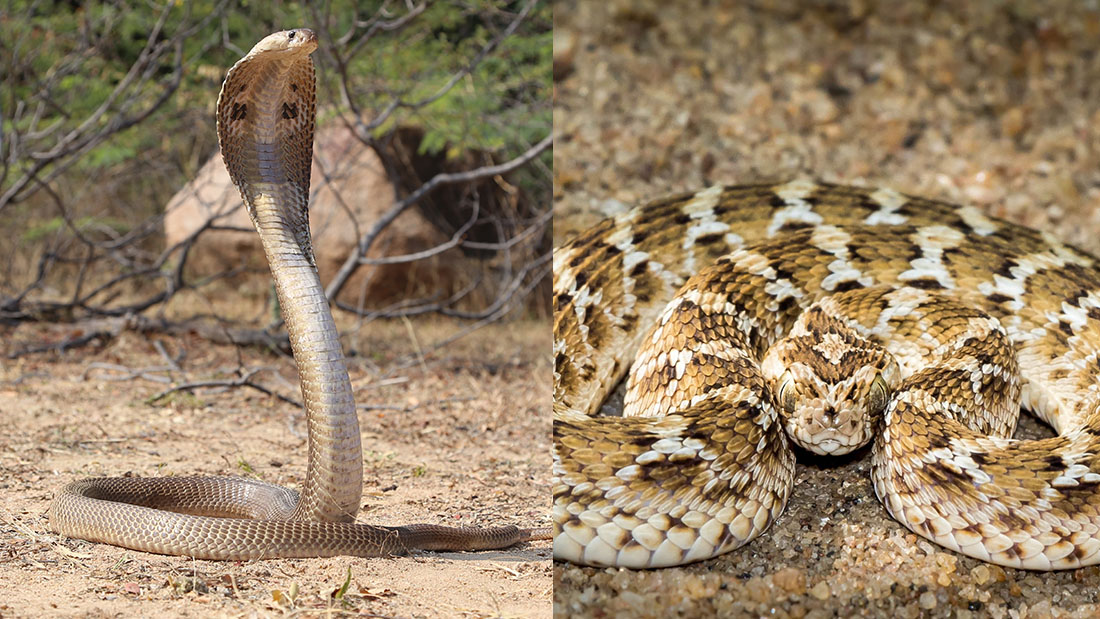Snakes are true killing and eating machines. While some inject incredibly potent venom, others can swallow food five times larger than their own heads. Due to their unfused lower jaw, they’re able to swallow jaw-dropping-sized prey, and some even possess “bone-digesting” cells in their gastrointestinal tract. To top it all off, some species are also remarkably intelligent, but which one wins the title of deadliest snake species?
They say there’s more than one way to skin a cat – and snakes have more than one way to kill it first. Envenomation, constriction, or simply swallowing prey whole, snakes have a wide variety of weapons in their arsenal, so determining the “deadliest” is going to be down to semantics. Here, “deadliness” refers to venomous snake species’ ability to kill humans.
Which snake has the most potent venom?
Australia – home to most of the planet’s most nope-worthy species – is, unsurprisingly, where you’ll find the world’s most venomous snake, the inland taipan (Oxyuranus microlepidotus). The lethal dose 50 percent (LD50) test score of the inland taipan’s venom is 0.025 milligrams per kilogram, making it the most potent venom of any land snake. The controversial LD50 is a test of potency whereby the lower the number, the more deadly the toxin. The test involves injecting live mice with the amount of toxin required to kill 50 percent of the test animals, so in the case of the inland taipan, one bite could kill roughly 250,000 mice.
This surprisingly unremarkable-looking snake possesses venom so toxic that one bite is thought to be able to kill at least 100 adult humans. However, while it might be the world’s most venomous, calling it the “deadliest” snake species would be an unfair assessment.
The inland taipan is known to be incredibly shy and placid and does a good job of avoiding contact with humans. They’re also diurnal (active in the day) and rarely seen above ground, so it’s unlikely you’ll accidentally step on one. The same cannot be said for its fiery-tempered cousin, the coastal taipan (Oxyuranus scutellatus). Despite having markedly less potent venom, the coastal taipan has much larger fangs than the inland variety, is Australia’s longest venomous snake (at 2.9 meters, or 9.5 feet), and holds the record for the most amount of venom produced in one bite – with an LD50 of 0.099 milligrams per kilogram, that’s pretty deadly.

The inland taipan (left) and its spicy cousin, the coastal taipan (right).
Image credit: Ken Griffiths / Shutterstock.com
In fact, while around 11 people are known to have been bitten by the inland taipan, there are no recorded human fatalities due to the swift administration of antivenom. World’s deadliest snake? We think not!
Which snake kills the most people annually?
There is one country where the number of deaths by snakebite far exceeds any other country, and this is in no small part due to the fact that it’s home to the Big Four – the four species of venomous snake that cause the most human deaths annually.
No, we’re not talking about Australia this time. It’s estimated that up to 2 million people are envenomed by snakes each year in Asia, and a large proportion of these occur in India, which is home to the “Big Four”.
Made up of the Russell’s viper (Daboia russelii), the common krait (Bungarus caeruleus), the Indian cobra (Naja naja), and the saw-scaled viper (Echis carinatus), these four species alone are thought to be responsible for between 46,000 and 60,000 deaths in India each year. Considering there is an annual estimate of around 81-140,000 total snakebite deaths globally, the Big Four make up a large percentage of them.
So, what about these snakes makes them so deadly? The common krait has the most potent venom of the four, fifteen times more virulent than its deadly counterpart, the Indian cobra, and is likely the most venomous snake in the whole continent of Asia. Their population is dense, they’re nocturnal (awake at night), and they often seek shelter in human-made structures, making chance encounters with them more likely.
The Russell’s viper is a highly intelligent species capable of striking from up to 1.5 meters (5 feet) away. Unlike other venomous species, the Russell’s viper doesn’t need to hold onto its prey to inject its venom; a quick bite is all it takes.

Don’t let the common krait’s (left) mlem fool you, it’s just as deadly as the Russell’s viper (right).
Image credit: Manishankar Patra / Lauren Suryanata / Shutterstock.com
Not to be confused with the King Cobra, the Indian cobra has a similar, distinctive hood and is also highly intelligent. The only diurnal (awake during the day) species of the Big Four, Indian cobras have a fast-acting, potent venom that can cause respiratory distress and cardiac arrest within 30 minutes to 2 hours of being bitten.
Lastly, the saw-scaled viper is the smallest of the group, but don’t let that fool you. Due to their widespread distribution and their irritable and defensive behaviour, these spicy noodles are thought to be responsible for more deaths than all other snake species combined in the areas they inhabit. When threatened, the saw-scaled viper coils into an S shape and rubs its rough scales together to make a hissing sound as a form of defense.

The Indian cobra (left) displays its hood in defence, while the saw-scaled viper (right) coils tightly.
Image credit: Casjahn / Dushan Muthunayake / Shutterstock.com
While there’s no denying that the Big Four are a very deadly gang of serpents, there are other factors at play that mean bites from these species are more likely to result in death.
India’s landmass covers approximately 2.4 percent of the world’s total land area, and yet it’s home to over 17.7 percent of the global population. The country’s dense population means humans are more frequently encroaching on snake habitats, and the destruction of their natural homes means snakes are more likely to venture closer to humans in search of food and shelter.
Additionally, some rural and remote areas – where most Big Four snakebites occur – have sparse and less equipped medical facilities. With potent snake venom killing in just a few short hours, if the distance to the nearest medical facility with the correct antivenom is too far, the patient likely won’t survive the journey. There’s even some research that suggests that the polyvalent antivenoms used to treat the Big Four bites in India may not be that effective.
There are many more factors than just venom potency at play when trying to determine which is the “deadliest” snake species, and there isn’t one simple answer. So, instead, just remember to learn to identify your local snake species, keep a respectful distance from any wild snake (or wild animal generally), and check out the world’s tiniest snake that’s definitely not going to kill you.
Source Link: Inland Taipan: The Deadliest Snake In The World?